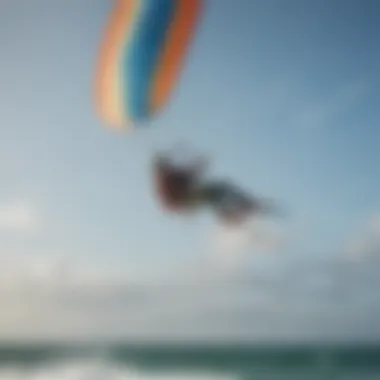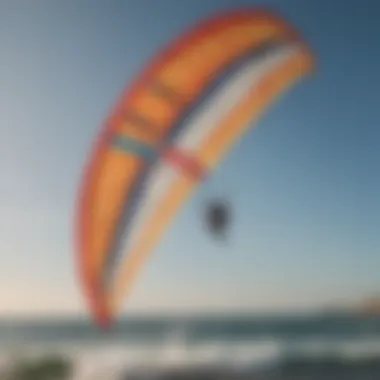A Comprehensive Guide to Choosing the Best Kite for Beginners in Kitesurfing and Kiteboarding


Equipment Reviews
When embarking on a kitesurfing or kiteboarding journey as a beginner, selecting the right kite is of paramount importance. The various kite models in today's market offer a plethora of features that cater to different preferences and skill levels. Understanding the nuances of kite shapes, sizes, materials, and brands is essential in making an informed choice. From delta kites to bow kites, each design influences performance and versatility, while materials like ripstop nylon or dacron impact durability and responsiveness. Top brands such as Cabrinha, Naish, and Slingshot each bring unique innovations to the table, enhancing the overall kiting experience.
Travel Destinations
As a kitesurfer or kiteboarder, exploring popular spots known for their ideal wind conditions and stunning views adds a thrill to the sport. Destinations like Tarifa in Spain, Maui in Hawaii, and Cape Town in South Africa offer not only excellent kiting opportunities but also vibrant local amenities and attractions for a well-rounded experience. Meanwhile, venturing off the beaten path to lesser-known gems like Prea in Brazil or Dakhla in Morocco unveils hidden paradises with uncrowded waters and unique landscapes. These destinations present the chance to escape the tourist crowds and immerse in the serenity of untouched kitesurfing spots.
Techniques and Tutorials
For beginners eager to master the basics of kitesurfing, step-by-step guides on launching, riding, turning, and landing techniques lay a solid foundation for skill development. Understanding wind directions, harnessing the power of the kite, and maintaining proper body posture are key elements in these tutorials. As riders progress to more advanced skills, tutorials on executing jumps, tricks, wave riding, and freestyle maneuvers provide a roadmap for pushing boundaries and honing expertise. From body drags to backrolls, these tutorials blend theory with practice to refine riding style and expand trick repertoire.
Safety Guidelines
The safety of kitesurfers and kiteboarders hinges on a comprehensive understanding of weather conditions and their impact on water sports activities. Knowledge of wind patterns, currents, tides, and local weather warnings is vital for assessing risk and ensuring a safe session on the water. Equally critical are emergency protocols that outline rescue tactics, communication procedures, and first aid measures in the event of accidents or mishaps. Regular equipment maintenance is non-negotiable in the world of kitesurfing, with routine checks on lines, bridles, kites, and safety gear ensuring optimal performance and minimizing risks during each session.
Understanding Kite Basics
Kite basics are paramount in the realm of kitesurfing and kiteboarding, serving as the foundation upon which enthusiasts build their skills and knowledge. Understanding the different kite types, key components, and functionality is crucial for beginners to make informed decisions about their equipment. By delving into kite basics, enthusiasts can enhance their safety, performance, and overall enjoyment of the sport.
Types of Kites for Beginners
Leading Edge Inflatable (LEI) Kites
Leading Edge Inflatable (LEI) kites are renowned for their versatility and stability in various wind conditions. Their inflated leading edge provides structure and aerodynamic efficiency, allowing beginners to navigate the wind window with ease. The key characteristic of LEI kites lies in their safety features, as they can easily relaunch from the water and depower quickly if necessary. While their setup may require more time compared to other kite types, LEI kites offer excellent wind range and user-friendly control.
Foils
Foils are recognized for their simplicity and lightweight design, making them ideal for beginners seeking maneuverability and ease of use. The key characteristic of foil kites lies in their ability to generate considerable power even in lighter winds, providing a thrilling experience for novice riders. However, foils might be less forgiving in crashes and may require more expertise to relaunch from the water compared to LEI kites.
Hybrid Kites
Hybrid kites combine the best features of LEI and foil kites, offering a versatile option for beginners looking to explore different riding styles. The key characteristic of hybrid kites is their adaptability to various wind conditions and riding preferences. With a mixture of stability, power, and responsiveness, hybrid kites provide beginners with a well-rounded experience on the water. However, their complexity and setup may require additional learning curve compared to other kite types.
Key Components of a Kite
Canopy


The canopy of a kite represents its surface area and shape, directly influencing its performance and flight characteristics. A well-designed canopy ensures efficient airflow and lift, enabling the kite to generate power and maneuver smoothly through the wind window. The key advantage of a quality canopy lies in its stability and responsiveness, offering beginners a reliable kite control experience. However, larger canopies may lead to higher drag and slower turns in strong winds.
Bridle System
The bridle system of a kite plays a vital role in distributing power, maintaining shape, and controlling the angle of attack. By adjusting the bridle settings, beginners can fine-tune their kite's performance to suit different wind conditions and riding styles. The key feature of a well-crafted bridle system is its ability to enhance stability and depower the kite effectively, promoting a safer and smoother ride for novice enthusiasts. However, intricate bridle setups may require more maintenance and adjustments over time.
Control Bar
The control bar serves as the primary interface between the rider and the kite, allowing for precise steering, power management, and relaunch control. A well-designed control bar offers ergonomic grips, intuitive safety systems, and clear visual indicators to enhance the rider's experience on the water. The key advantage of a quality control bar lies in its responsiveness and ease of use, providing beginners with confidence and control during their kitesurfing sessions. However, advanced control bars with additional features may come at a higher cost and require familiarity with their functionalities.
Factors to Consider
When it comes to choosing the best kite for beginners, various factors must be taken into consideration to ensure a smooth and safe kitesurfing or kiteboarding experience. Understanding these factors is crucial for making informed decisions that align with your skill level and preferences. Factors like size, wind range, safety features, ease of use, and performance considerations play a vital role in the selection process.
Size and Wind Range
Matching the Kite Size to Your Weight and Wind Conditions
Selecting the appropriate kite size based on your weight and the wind conditions you expect to encounter is paramount in ensuring optimal performance and safety. Matching the kite size to your weight helps maintain control and stability during your session. Additionally, choosing the right size according to wind conditions significantly impacts your ability to harness the power of the wind effectively. It is essential to find the perfect balance that complements your body weight and the prevailing wind speeds for a seamless kitesurfing experience.
Understanding Wind Window
Understanding the concept of the wind window is fundamental for beginners as it dictates the kite's flight path and power zone. The wind window represents the area in the sky where the kite can fly and generate power. A comprehensive grasp of the wind window enables riders to position their kites optimally to catch the wind and control their speed and direction effectively. By mastering the wind window, beginners can enhance their maneuvering skills and maximize their kitesurfing or kiteboarding capabilities.
Safety Features
Depower System
The depower system is a crucial safety feature that allows riders to reduce the kite's power swiftly, enhancing control and stability, especially in challenging conditions. This mechanism enables kiters to depower the kite during gusts or emergencies, minimizing the risk of accidents and ensuring a safe ride. Incorporating a reliable depower system in your kite setup is essential for maintaining a secure and controlled kitesurfing experience.
Safety Leash
A safety leash acts as a vital link between the rider and the kite, providing an emergency release option in unfavorable situations. This component ensures that kiters can detach themselves from the kite swiftly, preventing potential hazards and accidents. Safety leashes are designed to offer quick and efficient release, adding an extra layer of security for beginners learning the ropes of kitesurfing or kiteboarding.
Quick Release Mechanism
The quick release mechanism is a valuable safety feature that allows riders to detach the kite from their harness promptly. In case of emergencies or entanglements, this mechanism provides a quick and easy way to release the kite, averting potential dangers and ensuring a smooth bailout. Integrating a reliable quick release system into your kitesurfing gear is essential for maintaining optimal safety standards and maneuverability on the water.


Ease of Use
Relaunch Ability
Relaunch ability refers to the kite's capability to get back in the air from the water after crashing or stalling. A kite with excellent relaunch ability facilitates a smoother learning curve for beginners, allowing them to recover swiftly and resume their ride effortlessly. Opting for a kite with superior relaunch ability enhances the overall kitesurfing experience, providing added convenience and reducing downtime spent on troubleshooting.
Stability
Stability is a critical factor that contributes to the ease of control and maneuverability of a kite. A stable kite maintains consistent flight characteristics in various wind conditions, offering riders greater stability and predictability during their sessions. Choosing a kite known for its stability ensures a more user-friendly experience, especially for beginners honing their kitesurfing skills and building confidence on the water.
Control
Control plays a pivotal role in kitesurfing and kiteboarding, influencing the rider's ability to steer the kite and navigate through different maneuvers effectively. Optimal control over the kite allows riders to adjust their speed, direction, and power output with precision, enhancing their overall performance on the water. Selecting a kite that offers responsive and intuitive control features is essential for beginners looking to refine their skills and master the art of kitesurfing with finesse.
Performance Considerations
When choosing the best kite for beginners in kitesurfing or kiteboarding, understanding performance considerations is paramount. Performance factors directly impact the kite's behavior and efficiency during your sessions on the water, influencing your overall experience and skill development. In this section, we delve into the critical elements that determine a kite's performance and how they relate to your progression in the sport.
Turning and Maneuverability
Low-End Power
Low-end power plays a crucial role in a kite's ability to generate traction and pull in lighter winds. This feature is particularly advantageous for beginners as it allows for easier water relaunch and enhanced control when winds are not at their strongest. The unique characteristic of low-end power lies in its capacity to maintain kite stability and responsiveness even in marginal wind conditions. While it empowers riders to navigate with precision, one must also be mindful of potential overpowering effects during gusty winds. Understanding and harnessing low-end power effectively improve a beginner's kite-handling skills and overall performance.
Upwind Performance
Upwind performance signifies a kite's capability to sail against the wind direction efficiently. This aspect is essential for beginners looking to progress in the sport, as it aids in maximizing ride time and conquering new challenges. The key characteristic of upwind performance lies in its strategic design elements that enable the kite to catch the wind effectively and propel the rider forward. By mastering upwind riding, beginners can explore different areas on the water and eventually enhance their overall kitesurfing or kiteboarding experience. However, it is essential to note that achieving optimal upwind performance may require practice and adjustment to variable wind conditions.
Power and Speed
Boosting and Hang Time
Boosting and hang time are critical aspects that contribute to a kite's power and speed capabilities. Boosting refers to the kite's ability to propel riders into the air, creating opportunities for aerial tricks and maneuvers. Hang time, on the other hand, relates to the duration a rider stays in the air before landing back on the water. These features are highly sought after by adrenaline-seeking beginners looking to elevate their riding experience and showcase their skills. The unique characteristic of boosting and hang time lies in the thrill and excitement they offer, pushing riders to push their limits and explore new heights in kitesurfing or kiteboarding. While exhilarating, riders must also exercise caution and proper technique to ensure safe and controlled landings.
Kiteloops
Kiteloops represent a dynamic maneuver where the kite is looped through the power zone, generating rapid speed and pull. This advanced technique adds an element of excitement and challenge for beginners seeking to enhance their performance on the water. The key characteristic of kiteloops lies in their ability to create explosive power and momentum, allowing riders to execute impressive aerial rotations and tricks. Engaging in kiteloops requires precision, timing, and confidence to execute maneuvers smoothly and safely. While exhilarating, riders must gradually ease into practicing kiteloops to build proficiency and ensure a fulfilling kitesurfing or kiteboarding experience.


Budget-Friendly Options
In the realm of kitesurfing and kiteboarding, the concept of budget-friendly options holds significant importance, especially for beginners venturing into these exhilarating water sports. When considering budget-friendly options, there are specific elements that play a pivotal role in the decision-making process. These elements include affordability, quality, and the balance between price and features. By emphasizing budget-friendly options in this comprehensive guide, beginners can make informed choices that align with their financial constraints while not compromising on essential features necessary for an enjoyable and safe kiting experience.
Entry-Level Kites
Affordable Brands
One of the key aspects within budget-friendly options for beginner kiters is exploring affordable brands. Affordable brands are instrumental in making kitesurfing and kiteboarding more accessible to enthusiasts who are just starting in the sport. These brands typically offer entry-level kites that are priced competitively without compromising on basic functionalities and safety features. The affordability of these brands makes them a popular choice for beginners looking to invest in their first kite equipment without breaking the bank. Their affordability factor combined with decent quality and performance attributes makes them a sought-after option in the market.
Used vs. New
Another crucial consideration within the realm of budget-friendly options is the debate between purchasing used versus new kite gear. This comparison holds relevance in this article as it presents beginners with a viable alternative to buying brand-new equipment. Used kite gear often comes at a lower price point, allowing beginners to access higher-end models or brands that may have been unfeasible at retail prices. However, the trade-off lies in the potential wear and tear of used equipment compared to the reliability and warranty that new gear offers. Understanding the advantages and disadvantages of opting for used versus new equipment is imperative for beginners to make an informed decision based on their preferences and budget constraints.
Value for Money
Balancing Quality and Price
Value for money is a critical aspect to consider when delving into budget-friendly options for kiteboarding and kitesurfing. Balancing quality and price becomes a focal point in this article as beginners aim to maximize the utility and longevity of their kite gear within a reasonable budget. By focusing on this aspect, beginners can ensure that the kite they choose not only fits their financial parameters but also delivers performance and durability that justify the investment. Evaluating the quality-to-price ratio enables beginners to select kites that offer the best compromise between cost-effectiveness and functional excellence, enriching their overall kiting experience.
Tips for Beginners
As a beginner eager to delve into the thrilling world of kitesurfing or kiteboarding, understanding the nuances of choosing the right kite is paramount. The section on tips for beginners in this comprehensive guide serves as a crucial foundation for your journey towards selecting the ideal kite. Within this segment, we will explore essential insights and recommendations tailored to newcomers, ensuring a smooth transition into this exhilarating sport.
Embarking on any new endeavor can be overwhelming, but with the right guidance, the process becomes immensely more manageable. These tips for beginners aim to streamline your decision-making process, guiding you through the intricate landscape of kite selection. By grasping the nuances outlined in this section, you can approach choosing a kite with confidence, knowing that you are equipped with the knowledge necessary to make an informed choice.
Seeking Professional Advice
When delving into the realm of kitesurfing or kiteboarding, seeking professional advice can significantly impact your journey. Consulting instructors or local experts stands out as a pivotal aspect in aiding beginners in navigating the complexities of selecting the best kite for their skill level and needs. Eager novices can benefit immensely from the expertise and insights offered by seasoned professionals in the field.
The hallmark characteristic of consulting instructors or local experts lies in the wealth of experience and wisdom they bring to the table. Their profound understanding of kite mechanics, wind dynamics, and individual skill progressions enables them to provide tailored recommendations, personalized to each beginner's requirements. By tapping into this invaluable resource, beginners can fast-track their learning curve and avoid common pitfalls, ensuring a smoother entry into the sport.
Despite its many advantages, consulting instructors or local experts may present limitations such as scheduling constraints or geographical accessibility. However, the benefits far outweigh any minor drawbacks, as the guidance and mentorship provided can be instrumental in shaping a beginner's kitesurfing or kiteboarding journey. Achieving proficiency in kite selection and technique under the tutelage of experts can set the foundation for long-term success and enjoyment in the sport.
Test-Driving Kites
In the pursuit of choosing the best kite, the importance of test-driving cannot be overstated. Attending demos or rental programs offers beginners a hands-on experience that is invaluable in making an informed decision. This section delves into the significance of test-driving kites and the benefits it brings to aspiring kitesurfers and kiteboarders.
Attending demos or rental programs allows beginners to gauge the performance, handling, and suitability of different kites firsthand. This practical exposure empowers novices to assess various models in real-world conditions, providing invaluable insights that cannot be gleaned from theoretical knowledge alone. By experiencing the feel and responsiveness of different kites through direct interaction, beginners can refine their preferences and make educated choices.
The key characteristic of attending demos or rental programs lies in the opportunity for hands-on experimentation, enabling beginners to develop a tactile understanding of kite functionalities. This immersive learning experience fosters confidence and proficiency, aiding novices in narrowing down their options and selecting a kite that aligns with their evolving skills and preferences.
While attending demos or rental programs offers unparalleled advantages in the decision-making process, potential disadvantages may include limited availability of advanced models or variations during certain periods. However, the firsthand insights gained through test-driving kites outweigh any minor constraints, as the experiential knowledge acquired can significantly inform a beginner's kite selection, setting the stage for a rewarding kitesurfing or kiteboarding journey.







